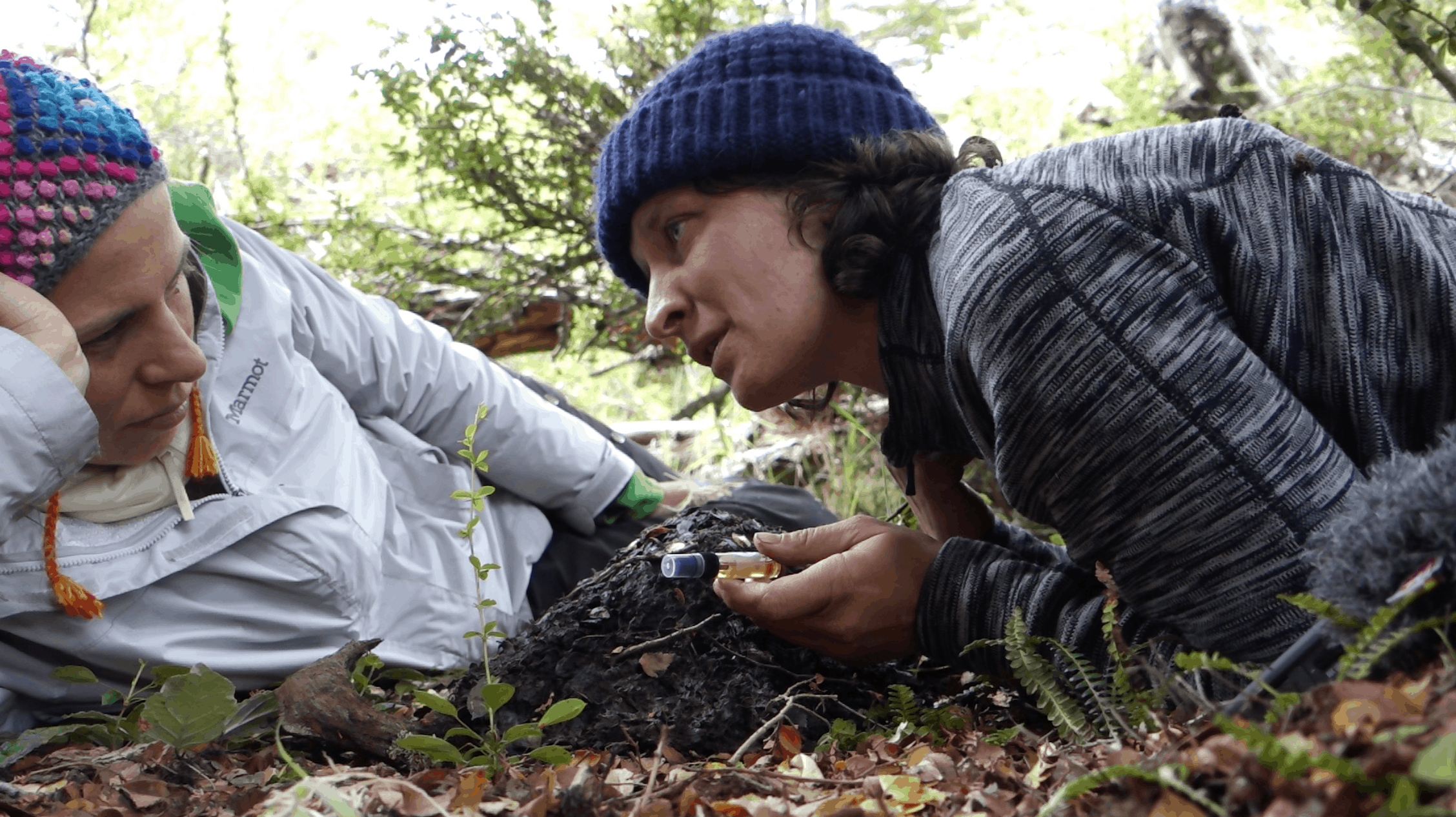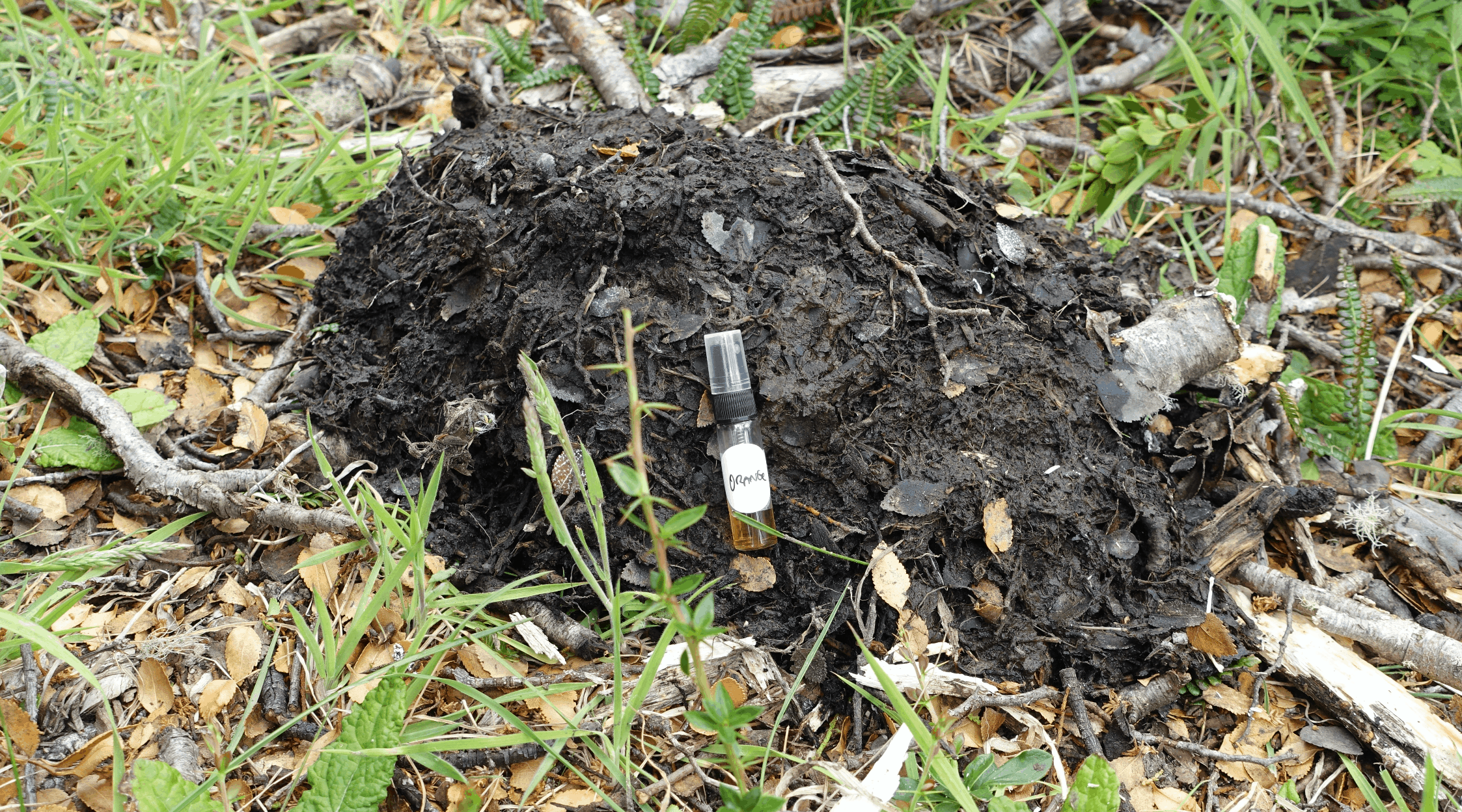Camila Marambio’s field notes
1st day (January 8, 2016):
Site selection, scent mound recognition, experimental scent mound molding, spraying scent mounds
The work of today was collective. Cristina, Julián and Christy and I sourced the material for building the mounds. We dug mud from the river bed and piled it over a precarious structure of twigs and sticks. This material was already very smelly itself. Soft deteriorating organic matter, anaerobically decomposing.
I oversaw the general shaping of the mounds, patting down the handfuls of mud to form the mound. I used sticks to do this, as extensions of my own hands, both because I wanted to embody a sense of otherness but also because I wanted to protect myself from the getting too cold. We should have brought a bucket. *There are tools that we could have next time: bucket, shovel, amongst others, but how much do we want to mechanize or professionalize this experiment is the honest question that assaults me as I make this observation.
We built four mounds on either side of the beaver lodge, according to the instructions that Derek and Giorgia gave us, the protocol. On finding the beaver lodge we distinguished what looked like an original beaver scent mound and built our experimental one in the likelihood of this one, respecting its height and width. Overall the size of our experimental mounds resembled the beaver mounds and were as apparently haphazardly assembled.
It was a cold day and we were at a site that was clearly active. My thoughts often strayed to think of the solitude of beavers, of how many days, weeks and even months they might spend in these forests without seeing humans. Their technology, beaver technology, it seem so suited to this territory which they reconfigure. Laboriously applying themselves, they fashion their homes.
We speculated as to whether we were sourcing mud from exactly their same site, and discussed trying not to get mud that would already be “scented” by beavers so that our scent could impress itself. Our scent… what are these really about? A scent that carries our intention to communicate with them. How do you communicate with someone whose language you do not speak? Well, you try and learn their language, and that is precisely what we have been applying ourselves to; our scents are not territorial markings in the traditional sense of these being a way stake out a territory. Our markings are the first attempts to speak a second language, to utter a few syllables in a tongue that is olfactory and that as such is clumsy but craves to establish contact. An encounter in or on or of new terms.
What are we trying to achieve? To establish a rapport, to create a lexicon, to recognize a common ground between us humans and the beavers of Tierra del Fuego.
We spoke of decomposition and of smells. We “ewed”, fussed, and overall amused ourselves. This playful character of the experiment is crucial to me. As I reviewed the video material Christy recorded I saw a family of beaver, two mothers (Camila and Christy), two children (Cristina and Julián). Going about their way, without much expertise, but with a whole lot of diligence. Sensibly I believe we are politically active, that we are driven by a very urgent agenda: to recompose a common world in which difference prevails.
After building the mounds we sprayed them with the scents, again following Derek and Giorgia’s protocol. In hindsight I wonder if we sprayed enough castoreum. Night time was almost falling upon us, so we retired.
2nd day (January 9, 2016):
Christy and I returned to the scent mounds to record interaction. Upon not finding any evident interaction, we decided to spend time with these “results”. To look, smell and think with an inclination to sensing the power of our uselessness.
Scent requires proximity, even though it is airborne it lands somewhere and emanates from some thing. Lying belly down on the went ground bringing our noses close to the earth, we sniffed. Lacking the refined language of “noses”, connoisseurs of perfumes, we fumbled for the words. Used cliches such as: floral, musky, earthy, manly, etc. I am not bothered by the evident unskillful descriptions because what the also evidence is a heartfelt attempt at exercising what Dona Haraway has called “becoming with”. Sympoiesis (interfacing between different viewpoints to establish a principle of collaboration ((synergy)) by which the expertise of either standpoint can be combined, and enhanced, to bring out new understanding) is the substance of ensayar, of Ensayos, and it has already afforded us/me so much. If it wouldn’t have been for our insistence on a collectively-producing system in which information and control are distributed among components, I wouldn’t have discovered that it is possible to travel through a time/space/mattering continuum to imagined spaces in the past/future/present in which I am a beaver, in which I know nothing, in which smelling an experiemntal scent mound is the most precious thing I could be doing, because it means nothing and yet has the absolute potential to surprise me.
As I hear Lola Kepja’s song to beach a whale with invisible arrows, I hear her skillful ensayos to collaborate with the whales of the Beagel Channel in the well being of her peoples without compromising the whale peoples. Why without compromising, because it is a call. Only those willful to respond to it shall.
I now sniff everything. It has become a custom or habit and what it has made me notice is that when I sniff, I touch. I get up too close, I break spatial boundaries of proximity and more often than not what I find is that texture and scent are intimately intertwined. The skin of a lime must be scraped to let loose the oily essence that is so uplifting, this perpetration of the surface is a leaning into lime.
As we leaned into the experimental scent mounds I discovered the small coigue leaves, the rotting pan del indio, the soot that lies beneath the floor of bark and dirt, I understood very viscerally that the beavers, the forest, the residues, the fungi, and I were all living and dying together.
I think now that we have to continue to pursue our wild speculation, our “curious practice”, our inclination to a multi-perspectivism, to losing one’s self in the shapeless smelling required to puncture our blind spots, our givens.




